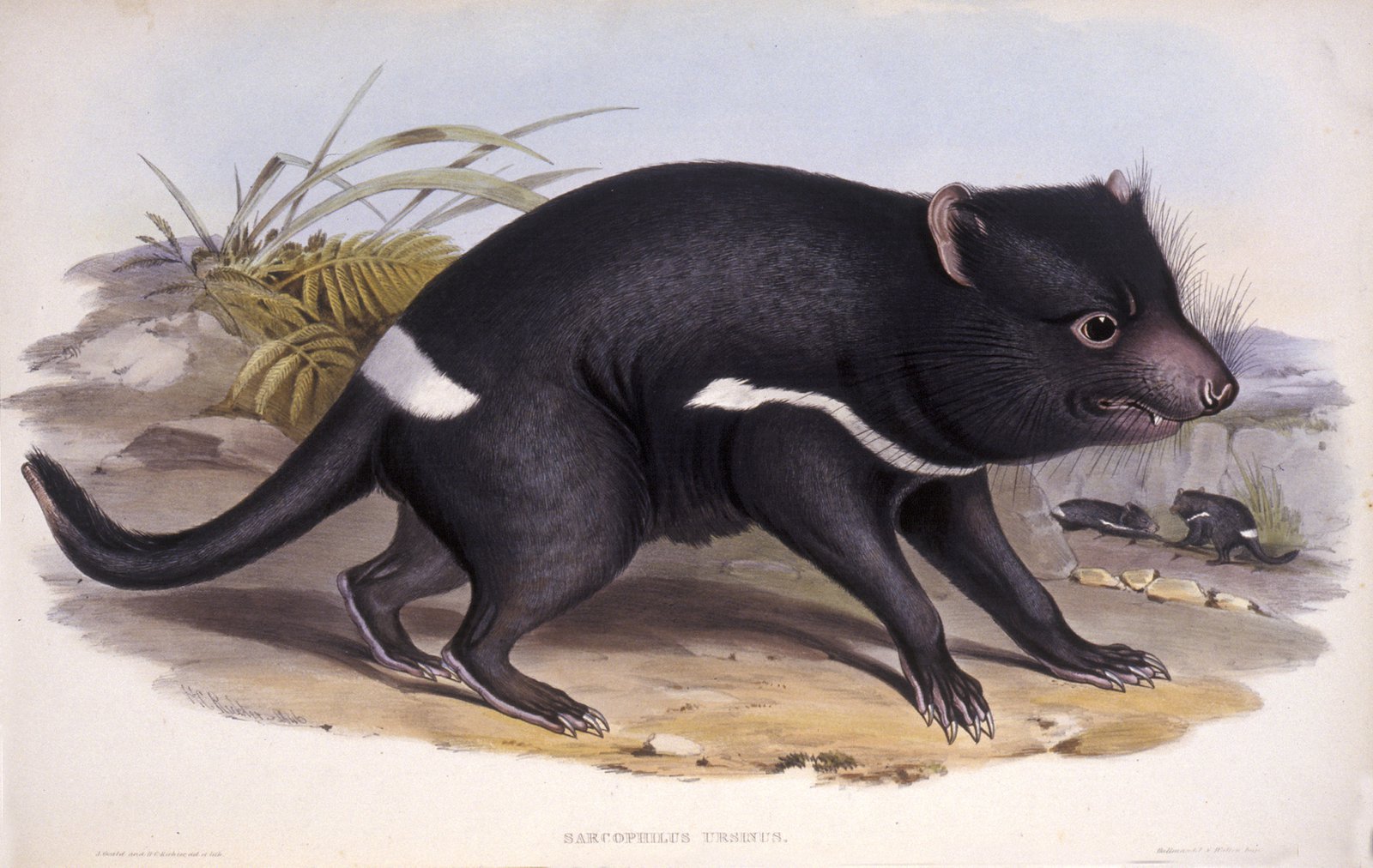How Will Tasmanian Devils Be Affected By Climate Change
The Tasmanian devil is the earth's largest surviving cannibal marsupial.
Identification
Having the appearance of a small canis familiaris, information technology is characterized by its black fur and white markings on the breast and some times rump. Their stocky nature is accentuated by their short muzzle and limbs.
Size range
55-65 cm head to tail; 24-25cm tail. Stand about 30cm high from the shoulder
Habitat
Devils are widespread across Tasmania from the coast to the mountains seeking out any areas where they can hide, shelter and find nutrient. These include coastal heaths, open up dry out sclerophyll forests and mixed sclerophyll-rainforest.
Distribution
Tasmanian Devils were once arable on mainland Australia equally evidenced by fossil remains. It is thought that they became extinct from the mainland about 400 years ago. They are widespread and common in Tasmania just are not plant on Bass Strait Isle, although subfossils have been found on Flinders Island.
Feeding and Diet
Tasmanian Devils are mainly scavengers feeding upon the carcasses of dead animals but can too be effective predators. Their source of food includes wallabies, small mammals, birds, reptiles, amphibians and insects. In farming areas they are also known to feed upon the carcasses of sheep and cattle. Their powerful jaws and teeth enable them to entirely devour their food including basic and fur. They are particularly renowned for their noisy communal eating during which use noise and threatening physical displays to affirm dominance amongst the pack.
Other behaviours and adaptations
Devils are nocturnal who spend their nights roaming smashing distances (upward to xvi km) in search of food. During the 24-hour interval they hide in their den or in dense bush land. Devils are not territorial only they do have a habitation range. Devils have a reputation for existence aggressive due to their famous threatening gape and for the range of fierce noises they make. Almost of these displays however are used every bit role of feeding rituals or produced through fear rather than aggression. Young devils are quite agile and can climb copse. They are also spend a lot of fourth dimension in playing with each other which involves wrestling, biting, chewing and creating a lot of noise. This kind of behaviour will be put in to practise at repast times equally adult devils

Illustration from Mammals of Australia - Feathers collection. The Tasmanian devil is the earth's largest surviving cannibal marsupial. Having the appearance of a small dog, it is characterised by its black fur and white markings on the chest and some times rump. Their stocky nature is accentuated past their curt cage and limbs. Image: Stuart Humphreys
© Australian Museum
Mating and reproduction
Tasmanian Devils mature in their second year and usually mate in March. After a gestation period of 21 days the females give birth to between 20 and 30 young called 'Joeys'. Since the mother simply has four teats, nearly young will not survive. Mothers carry the young in a rear-facing pouch for about 4 months. After this period, the young are left in a den (oftentimes hollow logs) until they are fully weaned at 5-vi months.
Conservation Condition
Tasmanian Devils are wholly protected. They are listed equally 'endangered' under Tasmania's Threatened Species Protection Act 1995 (May 2008); the Commonwealth'south Environment Protection and Biodiversity Conservation Act 1999 (May 2009) and are placed on the Red Listing of the International Matrimony for the Conservation of Nature and Natural Resource (2008).
In the past numbers were controlled by the availability of food and loss of habitat but the greatest current threat for devils is the Devil Facial Neoplasm Disease (DFTD). This fatal condition is characterised by facial tumours and is one of only three contagious cancers e'er recorded. Information technology is believed to be transmitted from devil to devil through bitter.
Support our research
Help us to protect our vital natural and cultural heritage for generations to come. With your support, our scientists, explorers and educators tin can continue to do their groundbreaking work.
Brand a donation
Source: https://australian.museum/learn/animals/mammals/tasmanian-devil/
Posted by: martinpervou.blogspot.com

0 Response to "How Will Tasmanian Devils Be Affected By Climate Change"
Post a Comment